The Economics and Statistics Division maintains archives of previous publications for accountability purposes, but makes no updates to keep these documents current with the latest data revisions from Statistics Canada. As a result, information in older documents may not be accurate. Please exercise caution when referring to older documents. For the latest information and historical data, please contact the individual listed to the right.
<--- Return to Archive
For additional information relating to this article, please contact:
June 16, 2021ANALYSIS OF NOVA SCOTIA'S CONSUMER PRICE INDEX FOR MAY 2021 TRENDS – May 2021
Nova Scotia’s All-Items Consumer Price Index (CPI) increased 4.8% year-over-year in May 2021. Nationally, consumer prices were up 3.6% from a year earlier, following a 3.4% gain in April 2021.The increase nationally was the largest year-over-year increase since May 2011.
Statistics Canada noted that the national year-over-year increase recorded in May was led by rising prices for shelter, passenger vehicles and continued but smaller base year effects for gasoline, furniture, and beef products. In May 2020 prices began to recover from the initial pandemic related declines but remained below pre-pandemic levels which produced base-year effects on the year-over-year prices in May 2021.
Compared to April 2021, monthly consumer prices increased 0.6% in Nova Scotia and 0.5% in Canada.
Impact of COVID-19 on the Consumer Price Index
Statistics Canada continued special CPI program measures for May 2021. Due to COVID-19 impact on product availability, select sub-components of the CPI received temporary special imputations. The sub-indexes for travel tours, some components of spectator entertainment, recreational services, personal care services in some areas, and some components of use of recreational facilities and services in some areas were imputed from the monthly change in the all-items index - effectively removing the impact of these goods and services on the CPI. The price indexes for beer, wine and liquor served in licensed establishments were imputed in several regions, using the indexes to which consumers likely redirected their expenditures: beer, wine and liquor purchased from stores. Consistent with previous months affected by the COVID-19 pandemic, prices for suspended flights are excluded from the May CPI calculation because passengers were ultimately unable to consume them. As a result, selected sub-components of the air transportation index were imputed from the parent index (air transportation).
Prices increased year-over-year in all provinces led by Prince Edward Island (+6.0%). British Columbia and Saskatchewan had the slowest growth (both +2.7%).
Atlantic provinces posted higher year-over-year price increases as a result of fuel being used more commonly for home heating in the region. The price of fuel oil and other fuels are subject to changes in oil prices with prices remaining higher when compared to May 2020.

The main contributors to the monthly change (May 2021 vs April 2021) in Nova Scotia CPI were:
- Purchase and leasing of passenger vehicles (+1.6%)
- Homeowners' replacement cost (+2.6%)
- Gasoline (+2.0%)
- Rent (-1.3%)
- Women's clothing (-2.7%)
- Inter-city transportation (-3.3%)
The main contributors to the yearly change (May 2021 vs May 2020) in Nova Scotia CPI were:
- Gasoline (+62.3%)
- Fuel oil and other fuels (+48.2%)
- Homeowners’ replacement cost (+14.7%)
- Telephone services (-12.7%)
- Mortgage interest cost
- Fresh or frozen beef (-10.8%)
Nova Scotia’s consumer price inflation (year-over-year) excluding food and energy increased 2.8% in May 2021. Consumer prices excluding food and energy were up in all provinces led by Quebec (+3.6%) and Prince Edward Island (+2.9%). Saskatchewan had the lowest increase at 1.2%.
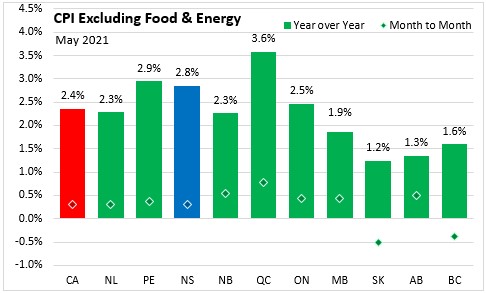
The CPI for food in Nova Scotia increased 1.2% year-over-year in May 2021. Nationally, food prices were up 1.5% from a year earlier. All provinces recorded year-over-year increase in food prices led by Prince Edward Island (+2.2%) and Alberta (+2.1%). Newfoundland and Labrador had the lowest increase at 0.7%.
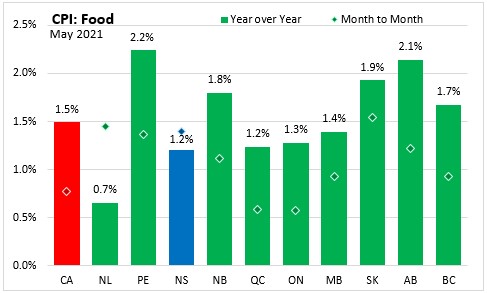
Nova Scotia energy prices increased 33.1% year-over-year in May 2021 compared to the national average of 26.4%. All provinces reported double digit increases in energy prices.
Gasoline prices in Canada increased 43.4% year-over-year in May 2021 following an increase of 62.5% in April 2021. In May 2020, gasoline prices began to recover from the initial impacts of the COVID-19. Gasoline prices increased 16.9% in May 2020 compared with April 2020, following declines of 17.8% in March and 15.2% in April 2020.
The year-over-year change in Nova Scotia’s CPI is more exposed to the effects of changes in oil prices on inflation due to a larger use of fuel as a source of home heating compared to other provinces.


Year-over-year, shelter costs in Nova Scotia increased 5.9% in May 2021, above the national average increase of 4.2%. Compared to May 2020, shelter prices were up in all provinces with the largest increase in Prince Edward Island (+11.0%) and the smallest increase in Saskatchewan (+0.3%).
Statistics Canada noted that the construction costs and demand for single-family homes continues to grow, pushing up the homeowners replacement cost index. Nationally, the homeowners replacement costs increased 11.3% and in Nova Scotia was up 14.7% year-over-year. This is partially offset by the decline in mortgage interest cost index over the past year.
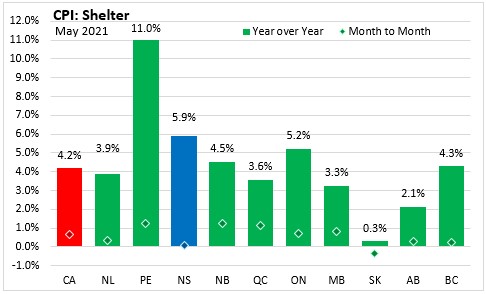
Nova Scotia's consumer price inflation (year-over-year growth in CPI) excluding energy was 2.6% in May compared to a national rate of 2.2%. Quebec (+3.0%) posted the largest year-over-year gain while the CPI excluding energy had the smallest change in Saskatchewan (+1.4%).
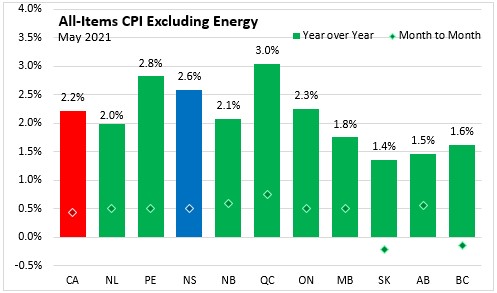
Major Components for May 2021
The following table shows the price increases specific to Nova Scotia for the major components of the CPI this month:
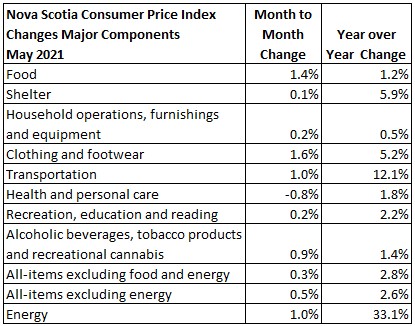
Long Run Trends
In May 2021, the All-Items CPI year-over-year inflation rate for Nova Scotia was 4.8%, above Canada's average rate at 3.6%. Month-to-month movements in the indices can be different, over time they generally follow the same overall trend. Nova Scotia’s all-items CPI increase of 4.8% was the largest increase since March 2003 (+6.9%).

Nova Scotia’s all-items CPI excluding food and energy increase of 2.8% was the largest increase since June 2003 (+3.0%).
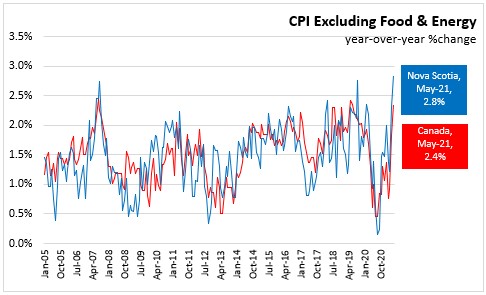
Bank of Canada's preferred measures of core inflation
Compared to May 2020, CPI-Common increased 1.8%, CPI-Median increased 2.4% and CPI-Trim was up 2.7% in Canada. All-items CPI excluding eight of the most volatile components as defined by the Bank of Canada and excluding the effect of changes in indirect taxes (formerly referred to as CPIX), rose 2.8% year-over-year. All the indexes year-over-year change were higher in May 2021 than last month.
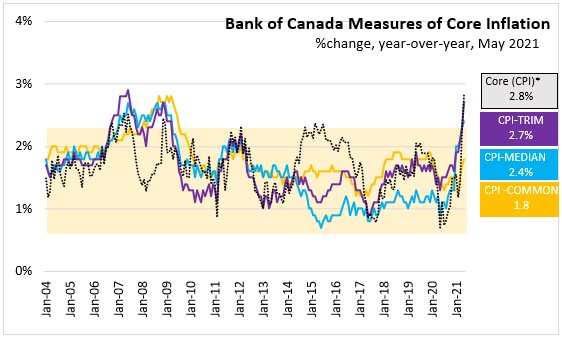
Appendix Tables and Charts

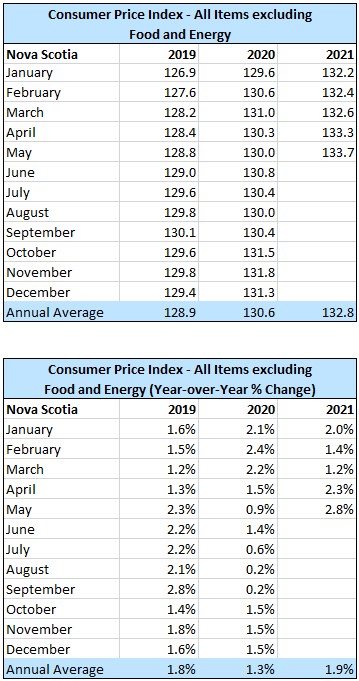
Source: Statistics Canada data portal: Tables 18-10-0004-01 and 18-10-0256-01
<--- Return to Archive